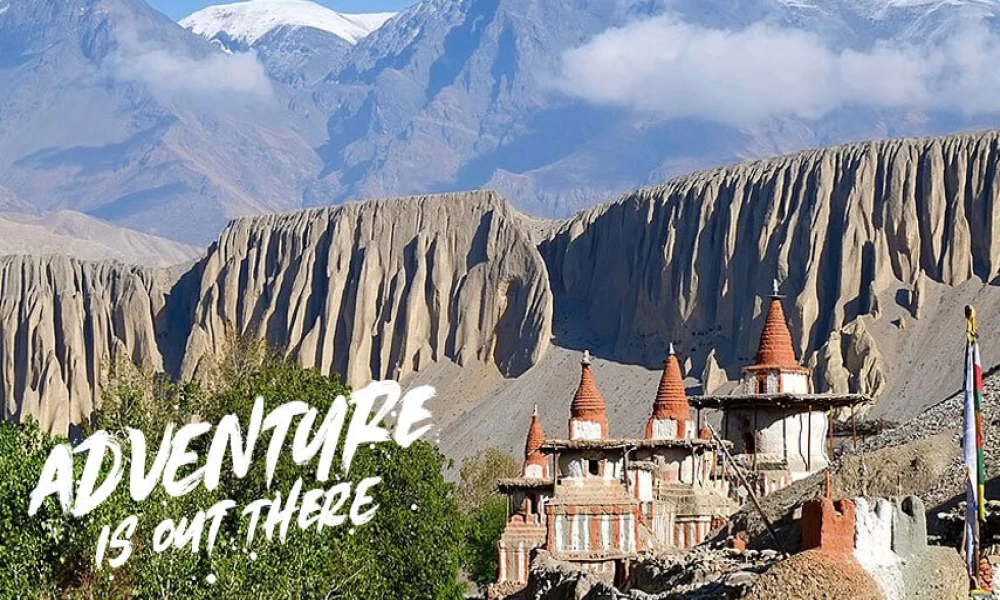Embark on the Upper Mustang Trek(Lo-Manthang), an unforgettable journey into Nepal’s ancient Forbidden Kingdom, where history, culture, and stunning landscapes meet. Located behind the Annapurna and Dhaulagiri ranges, Upper Mustang Trek ending at Lo Manthang offers an authentic Tibetan experience with its medieval monasteries, desert-like landscapes, and hidden caves. This adventure is perfect for cultural explorers, adventure seekers, and photographers looking to capture a unique Himalayan adventure.
Upper Mustang is known for its well-preserved Tibetan culture and untouched nature. Once the Kingdom of Lo, it is now part of Nepal and lies between Dolpo and Manang, bordering Tibet. The region is marked by "Mustang" signs, with permits checked at places like Kagbeni and Gyu La Pass. The people of Mustang follow Tibetan Buddhism and maintain their traditional lifestyle.
Located north of the Annapurna region, Upper Mustang sits at an average altitude of 4,000 meters, making it culturally and geologically part of the Tibetan plateau. The landscape features arid valleys, colorful rock formations, and cliffside cave dwellings. Only about 700 trekkers visit Upper Mustang annually, preserving its rich culture and natural beauty. The region is also known as the Kingdom of Horses, with Buddhist monasteries and nomadic traditions.
Upper Mustang has a rich history, with records dating back to the 8th century. It was once part of the western Tibetan region of Ngari and remained an independent principality until 1951. The land is filled with barley fields, pastures, and vast rolling hills shaped by the wind, with sun-baked mud bricks used for construction, including the palace at Lo Manthang.
A1 Excursion Adventure offers a 17-day Upper Mustang Trek designed to provide a tailor-made experience with a well-planned route, trek itinerary, and cost details. We look forward to guiding you through this unforgettable journey and creating lifelong memories.
Advantages of the Upper Mustang Trek - Lo Manthang with A1 Excursion Adventure
- Stress-Free Transfers
Enjoy complimentary airport transfers to and from Kathmandu International Airport for a hassle-free start to your trip.
- Thoughtful Travel Essentials
We provide essential gear like a duffle bag, water bottle, and T-shirt to make your journey easier.
- Safety First Principle
Stay safe with a first aid kit and oximeter to monitor oxygen levels at high altitudes.
- Authentic Cultural Immersion
Savor traditional flavors at local cultural restaurants with our welcome and farewell dinners.
- Comfortable Travel Experience
Travel light with free luggage storage and a detailed road map for your Upper Mustang Jeep Tour.
- Trekking Comfort
Stay warm with a free sleeping bag and inner liner for comfort during the trek.
- Best service guaranteed
Benefit from custom itineraries and expert guidance for a unique and memorable experience in the Upper Mustang Region. Best Service Guaranteed!
- Local Expertise & Personalized Service
Benefit from custom itineraries and expert guidance for a unique and memorable experience.
Major Attraction of Upper Mustang Trek Lo Manthang
Upper Mustang is filled with cultural treasures and breathtaking landscapes that attract travelers from all over the world. Here’s a look at some of its must-visit sites:
1. Jhong Cave – The Ancient Sky Caves
Carved into the cliffs, Jhong Cave offers a fascinating look into ancient Tibetan life. With its multi-story chambers and mysterious artifacts, it remains a site of historical intrigue
2. Ghar Gumba – A Sacred Monastery
One of the oldest monasteries in Mustang, Ghar Gumba is deeply connected to Guru Rinpoche. Its beautifully painted murals and sacred atmosphere make it an important pilgrimage site.
3. Muktinath Temple – A Holy Pilgrimage Site
Sacred to both Hindus and Buddhists, the Muktinath Temple is known for its holy water spouts and eternal flame, symbolizing purification and divine blessings.
4. Lo Manthang – The Walled City
A UNESCO-recognized ancient city, Lo Manthang is rich in culture and history. Visitors can explore its royal heritage, Tibetan-style architecture, and vibrant festivals like the Tiji Festival.
5. Royal Palace of Lo Manthang
Built in the 15th century, this historic palace was once the home of Mustang’s royal family. This five-story building stands as a symbol of the region’s royal and cultural legacy.
6. Marpha Village – The Apple Capital
Famous for its apple orchards and locally made apple brandy, Marpha Village offers a peaceful retreat surrounded by stunning landscapes. Marpha is one of the historical villages of Mustang. You will pass through this Marpha Village during the Jomsom Muktinath Trek and Upper Mustang Jeep Tour
7. Chug-shi (Ranchung)Cave – Guru Rinpoche’s Retreat
A sacred meditation site where Guru Rinpoche and Lord Shiva are believed to have meditated. This serene cave provides a tranquil space for reflection and spiritual connection.
8. Monasteries of Lo Manthang
The ancient monasteries of Lo Manthang, including Thubchen Gumba, Jampa Gumba, and Chode Gumba also known as Namgyal Monastery, offer deep insights into the region’s rich Buddhist heritage.
Other Upper Mustang Trek Packages We Offer
We offer various Upper Mustang Trek packages for an unforgettable journey through this remote region in Nepal. Experience the Tiji Festival, visit ancient monasteries, and enjoy stunning landscapes with guided treks and comfortable accommodations. Each season provides unique beauty for every trekker.
The packages offered are:
1. Upper Mustang Trek 18 days 2.Short Upper Mustang Trek 15 days
3. Upper Mustang Trek 4. Tiji Festival in Mustang May 27th, 28th and 29th 2025
Alternative Upper Mustang Jeep Tour Package
Suppose you're short on time but still want to experience this incredible journey. In that case, A1 Excursion Aventure offers a well-planned 10-day Upper Mustang Jeep Tour with Muktinath Temple as an alternative to trekking. This tour starts and ends in Pokhara, allowing you to explore the breathtaking landscapes of Mustang comfortably.
Upper Mustang Jeep Tour 10 Days
Book Your Adventure to the Upper Mustang Region Today!
Ready to embark on an unforgettable adventure in Upper Mustang with Muktinath Temple? Book now to secure your spot and start preparing for a trek filled with breathtaking landscapes, rich cultural heritage, and unforgettable memories in the Upper Mustang Region(Lo- Manthang) with A1 Excursion Adventure.








